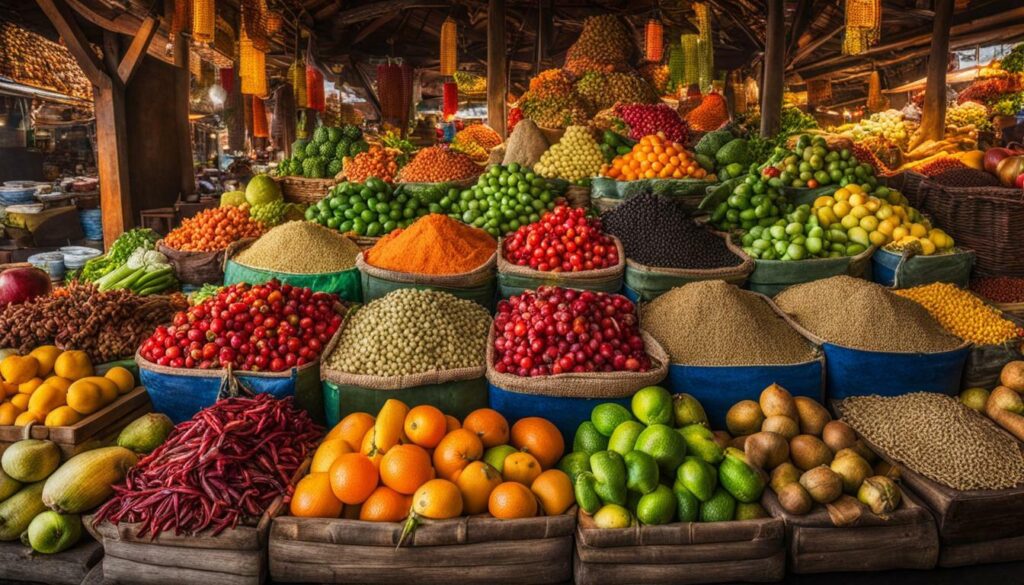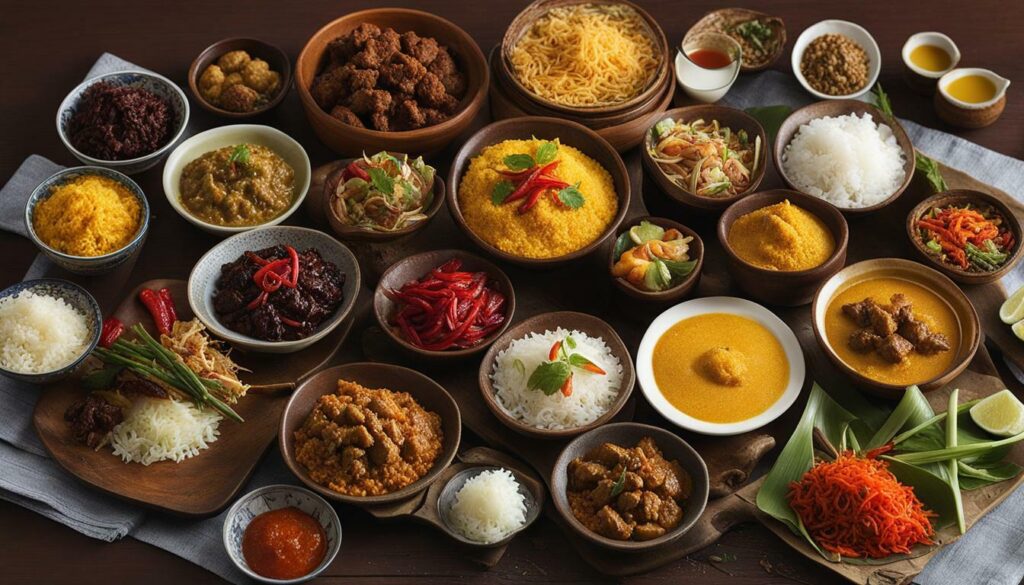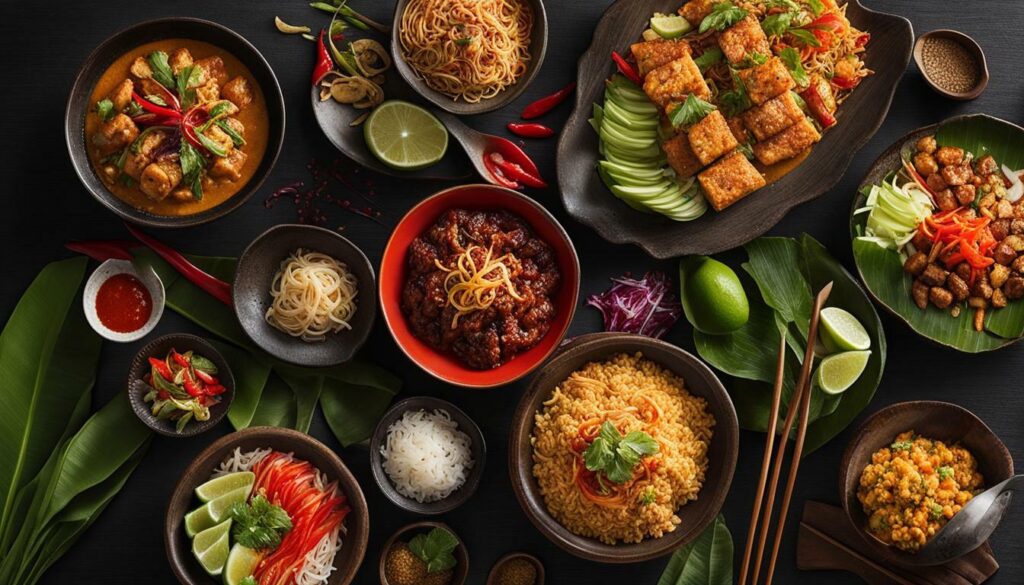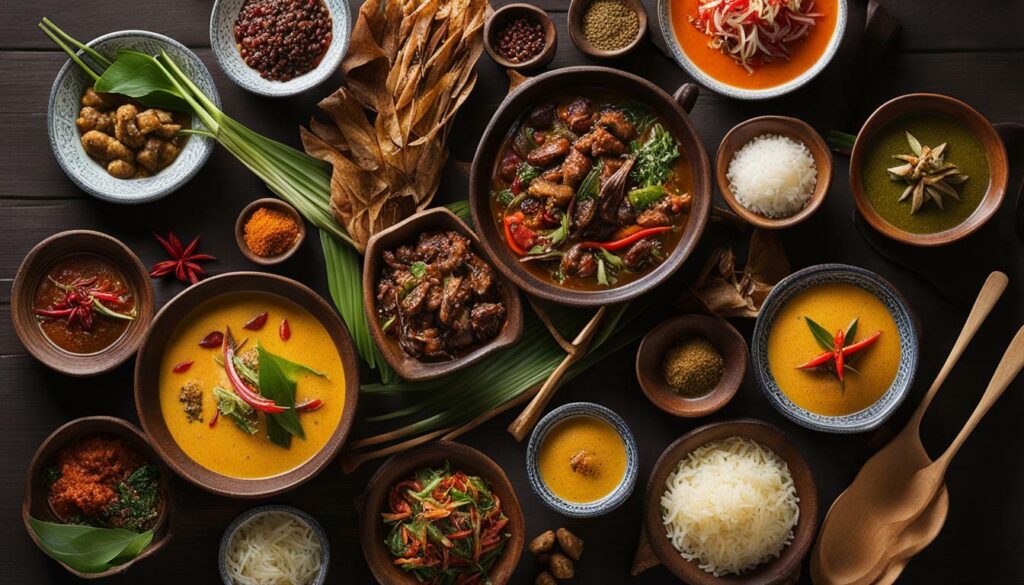Indonesian cuisine is a reflection of the country’s rich history, diverse geography, and vibrant culture, with a wide range of food traditions spread across its 17,000 islands. With a unique blend of influences from various regions and centuries of trade, Indonesian cuisine has evolved into a culinary experience like no other.
Indonesian cuisine is a vibrant tapestry of flavours, spices, and cooking techniques that have been passed down through generations. From traditional dishes to festive foods, the culinary traditions of Indonesia are deeply rooted in its cultural heritage.
Key Takeaways
- Indonesian cuisine reflects the country’s rich history, diverse geography, and vibrant culture.
- With 17,000 islands, Indonesia has a wide range of food traditions and regional variations in eating habits and recipes.
- Geographical influences play a significant role in shaping Indonesian cuisine, with coastal regions relying more on seafood and mountainous regions emphasizing meat, poultry, fruits, and vegetables.
- Food is an integral part of Indonesian rituals, ceremonies, and traditional practices.
- Indonesian cuisine is known for its use of spices and herbs, often processed into traditional healthy drinks called Jamu.
Geographical Influences on Indonesian Cuisine
The diverse geography of Indonesia, ranging from coastal areas to mountainous regions, has had a significant impact on the country’s culinary landscape. This has resulted in a wide variety of popular foods and meals that reflect the different regional traditions and ingredients.
Indonesia’s coastal areas are rich in marine resources, leading to a diet that is heavy on fish and seafood. Popular dishes such as ikan bakar (grilled fish) and sambal udang (shrimp in chilli sauce) are enjoyed by locals and visitors alike. On the other hand, the mountainous regions of the country offer a bounty of fresh produce, including tropical fruits and vegetables, as well as game meats. Dishes like sayur lodeh (vegetable stew) and rendang (slow-cooked beef curry) are staples in these areas.
Indonesian cuisine also places a strong emphasis on spices and herbs, which are used to add depth and flavour to dishes. The use of ingredients like lemongrass, ginger, turmeric, and chilli peppers gives Indonesian food its distinct taste and aroma. These spices are often processed into traditional healthy drinks called Jamu, which are believed to have various medicinal properties.
| Coastal Areas | Mountainous Regions |
|---|---|
| High consumption of fish and seafood | Abundance of fresh produce |
| Grilled fish (ikan bakar) | Vegetable stew (sayur lodeh) |
| Shrimp in chilli sauce (sambal udang) | Slow-cooked beef curry (rendang) |
With its diverse geography and rich culinary traditions, Indonesian cuisine offers a tantalizing culinary experience for food lovers. Whether you’re exploring the coastal regions or venturing into the mountains, you’re sure to find a wide array of delicious and unique dishes that showcase the flavours of Indonesia.

“Indonesian cuisine is a tapestry of flavors, influenced by its geographical diversity and cultural heritage. From the freshness of seafood along the coast to the rich spices found in the mountains, every bite tells a story of Indonesia’s culinary journey.” – Chef Made Adijaya
Traditional Culinary Practices in Indonesia
Traditional culinary practices in Indonesia are deeply rooted in the country’s rich cultural heritage and have been passed down through generations. Indonesian cuisine is a reflection of the diverse ethnic groups and their distinct traditions. The food not only nourishes the body but also plays a central role in religious ceremonies, social gatherings, and daily life.

The use of traditional spices and herbs is a hallmark of Indonesian cuisine. These aromatic ingredients, such as turmeric, lemongrass, and galangal, add depth and complexity to dishes. Traditional dishes are typically prepared using age-old techniques that require patience and skill. For example, the process of making rendang, a popular Indonesian beef dish, involves slow-cooking the meat in a mixture of spices and coconut milk for several hours until it becomes tender and flavorful.
A Taste of Tradition
“Indonesian cuisine is a reflection of the country’s cultural diversity and its long history. Each region has its own specialties and unique flavor combinations that are preserved and celebrated.”
Indonesia’s culinary traditions are also showcased in the vibrant street food culture. Stalls and carts dot the streets, offering an array of snacks and quick bites. From savoury satay skewers to crispy fried tempeh, these street foods capture the essence of Indonesian flavours and provide a glimpse into the daily lives of the locals.
As Indonesia continues to evolve, traditional culinary practices remain a vital part of the country’s identity. They serve as a link to the past while embracing the present. Indonesian chefs and home cooks alike strive to preserve these traditions while also incorporating modern influences and techniques. The result is a dynamic and ever-evolving culinary landscape that honours tradition while embracing innovation.
Traditional Indonesian Foods: A Culinary Tapestry
| Region | Specialty Dish |
|---|---|
| Sumatra | Rendang |
| Java | Gado-Gado |
| Bali | Babi Guling |
| Sulawesi | Coto Makassar |
| Maluku | Ikan Bakar |
| Papua | Papeda |
Indonesian Cuisine as a Cultural Identity
Indonesian cuisine serves as a reflection of the country’s cultural identity, with traditional dishes playing a significant role in defining its national character. The rich flavours, vibrant colours, and diverse ingredients found in Indonesian food are a testament to the country’s geographical and cultural influences. From the bustling streets of Jakarta to the tranquil rice fields of Bali, each region offers its unique culinary traditions that have been passed down through generations.
“Indonesian cuisine is a melting pot of flavors and techniques, combining elements from various ethnic groups and foreign influences,” says Chef Siti, a renowned Indonesian chef. “Our traditional dishes are not just about satisfying hunger; they are a celebration of our cultural heritage and a way to connect with our roots.”
One of the defining features of Indonesian cuisine is the use of aromatic spices and herbs. From turmeric and lemongrass to coriander and galangal, these ingredients infuse dishes with a distinct Indonesian flavour profile. The art of blending spices is a culinary tradition that has been passed down through generations, resulting in dishes such as rendang, a rich and spicy meat stew, and nasi goreng, a fragrant fried rice dish.
To truly experience Indonesian cuisine, one must indulge in the country’s national dishes. Nasi goreng, often referred to as the national dish of Indonesia, is a staple on every menu. This flavorful fried rice dish is made with a variety of ingredients such as shrimp, chicken, vegetables, and topped with a fried egg. Another iconic dish is satay, skewered and grilled meat served with a peanut sauce. These dishes not only showcase the diverse flavours of Indonesian cuisine but also embody the country’s rich culinary heritage.
Indonesia’s culinary traditions are not limited to its borders. Indonesian restaurants and street vendors can be found across the globe, serving up traditional dishes to both locals and tourists alike. With its bold flavours, vibrant colours, and diverse ingredients, Indonesian cuisine continues to captivate the hearts and taste buds of people worldwide, making it truly a national treasure.

| Popular Indonesian Dishes | Description |
|---|---|
| Nasi Goreng | A fragrant fried rice dish made with a variety of ingredients such as shrimp, chicken, and vegetables. |
| Satay | Skewered and grilled meat served with a peanut sauce, often enjoyed as a street food snack. |
| Gado-Gado | A refreshing salad made with blanched vegetables, tofu, tempeh, and a peanut sauce dressing. |
| Soto | A traditional Indonesian soup made with broth, meat, vegetables, and spices. |
Experience the Flavors of Indonesia
To truly immerse yourself in the vibrant and diverse world of Indonesian cuisine, it is essential to explore the local markets and street food stalls. Here, you can sample an array of traditional dishes and witness the skill and passion of the local cooks. From sizzling satay grilled right in front of your eyes to steaming bowls of aromatic soto, each bite tells a story of Indonesia’s rich culinary heritage.
- Visit the bustling Pasar Baru market in Jakarta and sample local delicacies such as bakso (meatball soup) and kerak telor (spiced omelette).
- Indulge in a seafood feast at the bustling Jimbaran Bay in Bali, where you can enjoy freshly grilled fish and prawns with breathtaking views of the sunset.
- Explore the vibrant street food scene of Yogyakarta, where you can savour signature dishes like gudeg (young jackfruit stew) and nasi kucing (cat rice).
Whether you are a culinary enthusiast or simply looking to expand your gastronomic horizons, Indonesian cuisine offers a world of flavours and experiences that are sure to leave you wanting more. So, grab a plate of nasi goreng, savour the rich spices, and embark on a culinary adventure through the diverse and delicious world of Indonesian cuisine.
Indonesian Street Food
Influences on Indonesian Cuisine
Indonesian cuisine has been influenced by a range of culinary traditions, including Indian, Middle Eastern, and Chinese cuisines, as well as centuries of trade with other countries. These external influences have contributed to the rich and diverse flavours that are characteristic of Indonesian dishes. Indian cuisine, with its aromatic spices and vibrant flavours, has had a significant impact on Indonesian cooking. The use of spices such as turmeric, cumin, and coriander can be traced back to the influence of Indian traders who brought their culinary traditions to the archipelago.
The Middle Eastern influence on Indonesian cuisine can be seen in the use of ingredients such as garlic, onions, and various nuts. The introduction of kebabs, baklava, and other Middle Eastern dishes has added a distinct flavour profile to Indonesian cooking. Chinese cuisine has also played a major role in shaping Indonesian food culture. The Chinese brought their cooking techniques, such as stir-frying and steaming, as well as ingredients like soy sauce and tofu, which are now integral to many Indonesian dishes.
The influence of these culinary traditions can be seen in popular Indonesian recipes such as Rendang, a spicy beef dish influenced by Indian and Middle Eastern flavours, and Nasi Goreng, a fried rice dish that incorporates Chinese cooking techniques. These dishes represent the blending of different culinary influences that have shaped Indonesian cuisine over the centuries.
The blending of flavours and techniques
“The diverse influences on Indonesian cuisine have resulted in a unique culinary landscape that blends flavours and techniques from various cultures,” says Chef Rahung Nasution, a renowned Indonesian chef. “We have taken the best from different cuisines and made it our own.”
The fusion of flavours in Indonesian cooking is a testament to the country’s history of trade and cultural exchange. Indonesian recipes often combine spices, herbs, and ingredients from different culinary traditions, resulting in a harmonious balance of tastes that is distinctively Indonesian.
A melting pot of flavours
Indonesia’s culinary heritage is a testament to its diverse cultural heritage and the influence of various culinary traditions. From the aromatic spices of Indian cuisine to the savoury flavours of Middle Eastern and Chinese dishes, Indonesian cuisine is a melting pot of flavours that reflects the country’s rich history and cultural diversity.
| Dish | Origin |
|---|---|
| Nasi Goreng | Chinese |
| Gado-Gado | Javanese |
| Satay | Malay |
| Soto | Javanese |
These popular Indonesian dishes showcase the diverse influences on Indonesian cuisine, from Chinese-inspired fried rice to Javanese-style salads and Malay-style grilled skewers. Each dish represents a unique blend of flavours and techniques that is distinctly Indonesian.

Indonesian cuisine continues to evolve, with modern influences and techniques being incorporated into traditional recipes. Indonesian chefs are known for their creativity and innovation, adapting international flavours and cooking methods to create new and exciting dishes that still pay homage to the country’s culinary traditions.
As Indonesian cuisine gains recognition on the global stage, it serves as a testament to the country’s cultural richness and culinary heritage. With its diverse influences and unique flavours, Indonesian cuisine offers a tantalizing culinary journey for food enthusiasts around the world.
Historical Roots of Indonesian Cuisine
The history of Indonesian cuisine can be traced back to ancient times, with rice serving as a staple food and the adoption of Indian and Middle Eastern culinary influences. As a country with a diverse population and a long history of trade and cultural exchange, Indonesia has absorbed various influences that have shaped its culinary traditions.

Indonesia’s strategic location along important trade routes brought Indian and Middle Eastern traders to its shores centuries ago. These early interactions introduced new ingredients, cooking techniques, and flavours to the local cuisine. The use of spices, such as cloves, nutmeg, and cinnamon, became prominent in Indonesian dishes, adding depth and complexity to the flavours.
Additionally, the spice trade in the 13th to 15th century further enriched Indonesian cuisine. Spice traders from Europe, especially the Portuguese and the Dutch, established settlements in Indonesia, bringing with them even more culinary influences. They introduced ingredients like tomatoes, potatoes, and chillies, which quickly became integral components of Indonesian dishes.
Over time, Indonesian cuisine has evolved and adapted, blending traditional recipes with modern influences and techniques. Chefs in Indonesia have creatively incorporated international flavours and cooking methods into traditional dishes, resulting in a fusion of old and new. Today, Indonesian cuisine continues to be a vibrant and integral part of the country’s cultural identity, celebrated for its rich flavours, diverse ingredients, and unique combinations of sweet, salty, sour, and bitter tastes.
Traditional Austronesian Culinary Practices
Indigenous inhabitants of Indonesia, such as the Bataks and Dayaks, have retained their traditional Austronesian culinary practices, which contribute to the diverse culinary landscape of the country. These communities have preserved their unique cooking techniques and ingredients, creating flavours and dishes that are distinct from their respective cultures.
The Bataks, who reside mainly in North Sumatra, have a cuisine that revolves around pork, freshwater fish, and vegetables. One of their signature dishes is called “saksang,” a deliciously spicy stew made with pork, blood, and various herbs and spices. It is traditionally served during important ceremonies and celebrations.
The Dayaks, on the other hand, are known for their traditional hunting and gathering practices. They rely heavily on the abundant resources of the rainforest, using ingredients such as wild game, sago palm, and various tropical fruits. A popular Dayak dish is the “pansoh manuk,” which is chicken cooked in bamboo over an open fire. This cooking technique infuses the dish with smoky flavours and gives it a unique aroma.

The culinary practices of the Bataks and Dayaks not only showcase the diversity of Indonesian cuisine but also highlight the deep connection between food and culture. These traditional Austronesian culinary practices have been passed down through generations, preserving the rich heritage and identity of these indigenous communities.
As Indonesia continues to evolve and embrace modern influences, it is vital to recognize and celebrate the traditional culinary practices of these indigenous groups. Their contributions to the culinary landscape of the country serve as a testament to the rich and vibrant gastronomic heritage of Indonesia.
Evolving Indonesian Cuisine
Indonesian cuisine continues to evolve as chefs blend traditional recipes with modern influences and techniques, resulting in unique and innovative flavours. This fusion of old and new creates a vibrant culinary landscape that caters to the diverse palates of locals and visitors alike. With a rich history and a deep appreciation for the abundance of natural ingredients, Indonesian chefs are constantly pushing the boundaries of traditional dishes.
The use of indigenous spices and herbs remains at the heart of Indonesian cuisine, but chefs are now experimenting with international flavours to create exciting new taste profiles. Indonesian recipes are being reinvented, incorporating elements from different cultures to provide a fresh take on classic dishes. This cross-cultural exchange is not only a reflection of Indonesia’s diverse population but also a testament to the country’s openness to culinary innovation.

A key aspect of the evolving Indonesian cuisine is the emphasis on presentation. Chefs are not only focused on creating delicious flavours, but also on crafting visually stunning dishes. Food presentation has become an art form, with intricate plating techniques and attention to detail. This elevates the dining experience and adds an extra layer of sensory delight.
The evolving Indonesian cuisine also extends beyond the traditional restaurant setting. Street food vendors and food markets play a vital role in showcasing the creativity and adaptability of Indonesian chefs. These bustling culinary hubs offer a wide array of dishes, from traditional favourites to modern street food creations. The street food scene in Indonesia is a vibrant and dynamic part of the country’s food culture, attracting locals and tourists alike.
Indonesian Recipes:
| Popular Indonesian Dishes | Ingredients |
|---|---|
| Nasi Goreng | Rice, shrimp paste, soy sauce, garlic, shallots, chicken, vegetables |
| Gado-Gado | Vegetables, tofu, tempeh, peanut sauce, boiled eggs, rice crackers |
| Satay | Grilled skewered meat (chicken, beef, or lamb), peanut sauce, rice cakes |
| Soto | Clear broth, chicken or beef, rice noodles, vegetables, herbs, lime |
Conclusion
In conclusion, Indonesian cuisine is a vibrant reflection of the country’s diverse geography, cultural heritage, and historical influences. With its 17,000 islands, Indonesia boasts a wide range of food traditions that vary from region to region, showcasing different eating habits and recipes. The cuisine is shaped by the country’s geographical position, as people living near the shore rely on fish and seafood, while those in the mountains enjoy meat, poultry, fruits, and vegetables.
Food holds great significance in Indonesian rituals and traditional practices, with more than 70 ceremonial events centred around food. Indonesian cuisine is known for its exotic spices and herbs, many of which are used to create traditional healthy drinks called Jamu. These culinary traditions have been developed and passed down through generations, forming an integral part of the country’s cultural identity.
Indonesian cuisine is not only enjoyed by locals but also attracts culinary tourists from around the world. Its rich flavours, combining sweet, salty, sour, and bitter tastes, tantalize the taste buds. Popular Indonesian dishes such as Nasi Goreng, Gado-Gado, Satay, and Soto have gained international recognition and are beloved by food enthusiasts.
The culinary landscape of Indonesia has been shaped by influences from Indian, Middle Eastern, and Chinese cuisines, as well as centuries of trade and cultural exchange with other countries. The spread of Islam also played a significant role, leading to the adoption of a halal diet that excludes pork. Furthermore, the historical roots of Indonesian cuisine can be traced back to ancient times, with rice serving as a staple food. The spice trade during the 13th to 15th century and the incorporation of Indian and Middle Eastern culinary influences further enriched Indonesian cuisine.
Finally, indigenous communities like the Bataks and Dayaks have preserved their traditional Austronesian culinary practices, showcasing the diversity within Indonesian cuisine. As culinary trends evolve, Indonesian chefs continue to blend traditional recipes with modern influences and techniques, keeping the cuisine dynamic and exciting.
FAQ
What factors have influenced Indonesian cuisine?
Indonesian cuisine is influenced by the country’s geography, culture, and history. The diverse food traditions are shaped by the 17,000 islands, regional variations in eating habits and recipes, and the availability of different ingredients.
How does geography influence Indonesian cuisine?
The geographical position of Indonesia plays a role in shaping its cuisine. People living near the shore have a diet rich in fish and seafood, while those in the mountains consume more meat, poultry, fruits, and vegetables.
What role does food play in Indonesian rituals and ceremonies?
Food holds significant importance in more than 70 traditional ceremonies in Indonesia. It is often the centre of interest and plays a crucial role in religious and cultural practices.
What are Jamu drinks in Indonesian cuisine?
Jamu drinks are traditional healthy drinks in Indonesian cuisine. They are made from various spices and herbs and are believed to have medicinal properties.
How does Indonesian cuisine represent the country’s cultural identity?
Indonesian cuisine is promoted as part of culinary tourism and is regarded as a reflection of the country’s cultural identity. The rich flavours and unique combination of tastes symbolize the diversity and cultural heritage of Indonesia.
What are some popular Indonesian dishes?
Nasi Goreng (fried rice), Gado-Gado (mixed vegetable salad with peanut sauce), Satay (grilled skewered meat), and Soto (aromatic soup) are among the popular dishes in Indonesian cuisine.
Which cuisines have influenced Indonesian cuisine?
Indonesian cuisine has been influenced by Indian, Middle Eastern, and Chinese cuisines over centuries of trade and cultural exchange. These influences have shaped the flavours and cooking techniques in Indonesian dishes.
What are the historical roots of Indonesian cuisine?
Indonesian cuisine has ancient roots, with rice being a staple food. The adoption of Indian and Middle Eastern culinary influences and the spice trade in the 13th to 15th century further enriched Indonesian cuisine.
Which indigenous culinary practices have been preserved in Indonesia?
Indigenous inhabitants of Indonesia, such as the Bataks and Dayaks, have retained their traditional Austronesian culinary practices. These include unique cooking techniques and the use of local ingredients.
How has Indonesian cuisine evolved over time?
Indonesian cuisine continues to evolve, blending traditional recipes with modern influences and techniques. Indonesian chefs have incorporated international flavours and cooking methods, creating innovative and contemporary dishes.
Source Links
- https://artsandculture.google.com/story/indonesia-food-101-indonesia-gastronomy-network/wgVRZGOnD65woQ?hl=en
- https://journalofethnicfoods.biomedcentral.com/articles/10.1186/s42779-019-0009-3
- https://en.wikipedia.org/wiki/Indonesian_cuisine



